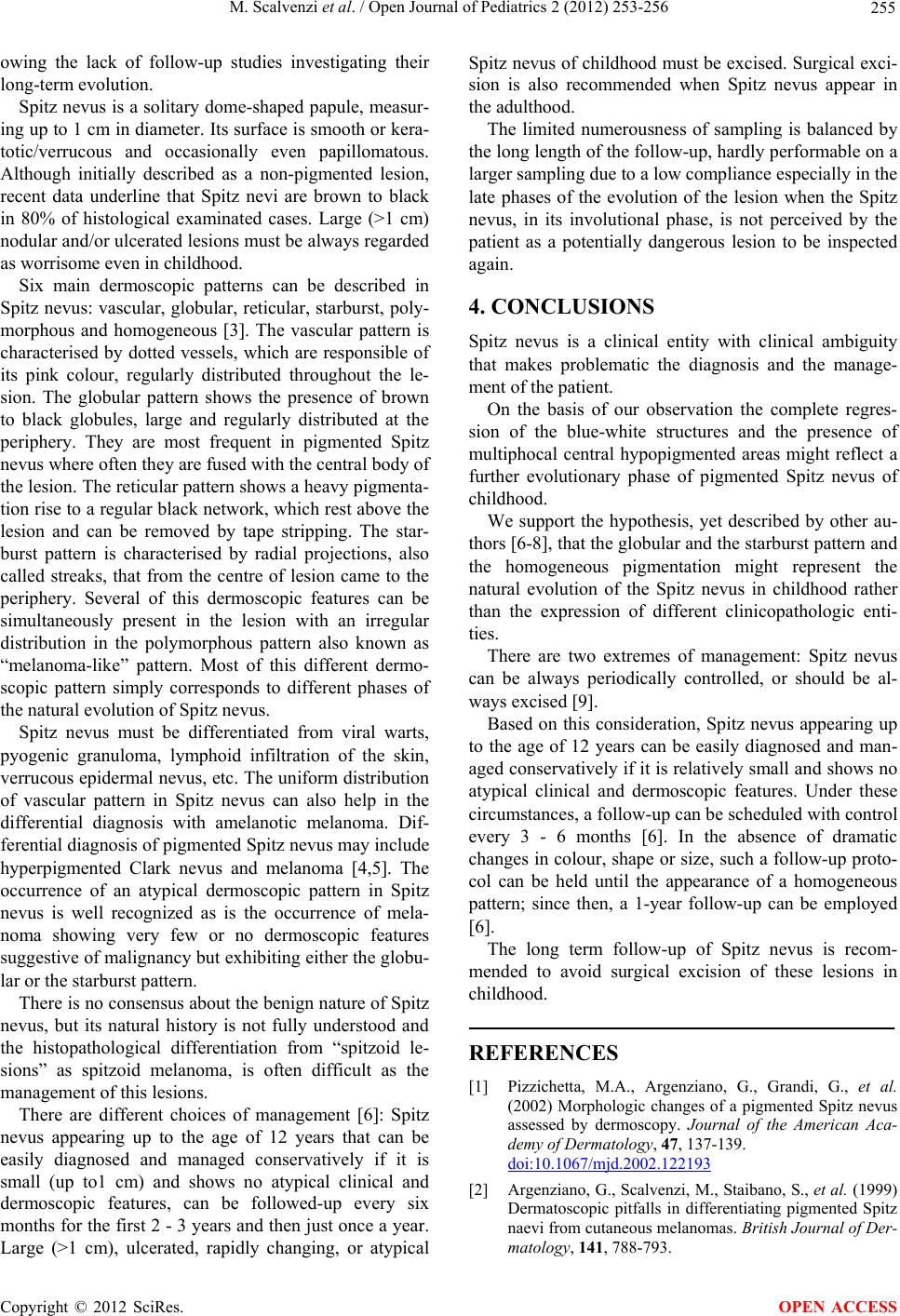
M. Scalvenzi et al. / Open Journal of Pediatrics 2 (2012) 253-256 255
owing the lack of follow-up studies investigating their
long-term evolution.
Spitz nevus is a solitary dome-shaped papule, measur-
ing up to 1 cm in diameter. Its surface is smooth or kera-
totic/verrucous and occasionally even papillomatous.
Although initially described as a non-pigmented lesion,
recent data underline that Spitz nevi are brown to black
in 80% of histological examinated cases. Large (>1 cm)
nodular and/or ulcerated lesions must be always regarded
as worrisome even in childhood.
Six main dermoscopic patterns can be described in
Spitz nevus: vascular, globular, reticular, starburst, poly-
morphous and homogeneous [3]. The vascular pattern is
characterised by dotted vessels, which are responsible of
its pink colour, regularly distributed throughout the le-
sion. The globular pattern shows the presence of brown
to black globules, large and regularly distributed at the
periphery. They are most frequent in pigmented Spitz
nevus where often they are fused with the central body of
the lesion. The reticular pattern shows a heavy pigmenta-
tion rise to a regular black network, which rest above the
lesion and can be removed by tape stripping. The star-
burst pattern is characterised by radial projections, also
called streaks, that from the centre of lesion came to the
periphery. Several of this dermoscopic features can be
simultaneously present in the lesion with an irregular
distribution in the polymorphous pattern also known as
“melanoma-like” pattern. Most of this different dermo-
scopic pattern simply corresponds to different phases of
the natural evolution of Spitz nevus.
Spitz nevus must be differentiated from viral warts,
pyogenic granuloma, lymphoid infiltration of the skin,
verrucous epidermal nevus, etc. The uniform distribution
of vascular pattern in Spitz nevus can also help in the
differential diagnosis with amelanotic melanoma. Dif-
ferential diagnosis of pigmented Spitz nevus may include
hyperpigmented Clark nevus and melanoma [4,5]. The
occurrence of an atypical dermoscopic pattern in Spitz
nevus is well recognized as is the occurrence of mela-
noma showing very few or no dermoscopic features
suggestive of malignancy but exhibiting either the globu-
lar or the starburst pattern.
There is no consensus about the benign nature of Spitz
nevus, but its natural history is not fully understood and
the histopathological differentiation from “spitzoid le-
sions” as spitzoid melanoma, is often difficult as the
management of this lesions.
There are different choices of management [6]: Spitz
nevus appearing up to the age of 12 years that can be
easily diagnosed and managed conservatively if it is
small (up to1 cm) and shows no atypical clinical and
dermoscopic features, can be followed-up every six
months for the first 2 - 3 years and then just once a year.
Large (>1 cm), ulcerated, rapidly changing, or atypical
Spitz nevus of childhood must be excised. Surgical exci-
sion is also recommended when Spitz nevus appear in
the adulthood.
The limited numerousness of sampling is balanced by
the long length of the follow-up, hardly performable on a
larger sampling due to a low compliance especially in the
late phases of the evolution of the lesion when the Spitz
nevus, in its involutional phase, is not perceived by the
patient as a potentially dangerous lesion to be inspected
again.
4. CONCLUSIONS
Spitz nevus is a clinical entity with clinical ambiguity
that makes problematic the diagnosis and the manage-
ment of the patient.
On the basis of our observation the complete regres-
sion of the blue-white structures and the presence of
multiphocal central hypopigmented areas might reflect a
further evolutionary phase of pigmented Spitz nevus of
childhood.
We support the hypothesis, yet described by other au-
thors [6-8], that the globular and the starburst pattern and
the homogeneous pigmentation might represent the
natural evolution of the Spitz nevus in childhood rather
than the expression of different clinicopathologic enti-
ties.
There are two extremes of management: Spitz nevus
can be always periodically controlled, or should be al-
ways excised [9].
Based on this consideration, Spitz nevus appearing up
to the age of 12 years can be easily diagnosed and man-
aged conservatively if it is relatively small and shows no
atypical clinical and dermoscopic features. Under these
circumstances, a follow-up can be scheduled with control
every 3 - 6 months [6]. In the absence of dramatic
changes in colour, shape or size, such a follow-up proto-
col can be held until the appearance of a homogeneous
pattern; since then, a 1-year follow-up can be employed
[6].
The long term follow-up of Spitz nevus is recom-
mended to avoid surgical excision of these lesions in
childhood.
REFERENCES
[1] Pizzichetta, M.A., Argenziano, G., Grandi, G., et al.
(2002) Morphologic changes of a pigmented Spitz nevus
assessed by dermoscopy. Journal of the American Aca-
demy of Dermatology, 47, 137-139.
doi:10.1067/mjd.2002.122193
[2] Argenziano, G., Scalvenzi, M., Staibano, S., et al. (1999)
Dermatoscopic pitfalls in differentiating pigmented Spitz
naevi from cutaneous melanomas. British Journal of Der-
matology, 141, 788-793.
Copyright © 2012 SciRes. OPEN ACCESS